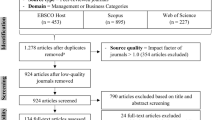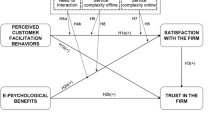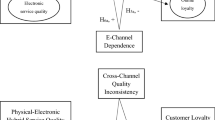Abstract
This study examines what drives customers' use of an online channel in a relational, multichannel environment. The authors propose a conceptual model of the determinants of online channel use and overall satisfaction with the service provider. They then conduct two large-scale studies in different service contexts to test the model. The results show that Web site design characteristics affect customer evaluations of online channel service quality and risk, which in turn drive online channel use. Customers' overall satisfaction with the service provider is determined by the service quality provided through both the online channel and the traditional channel. The results offer insights into the trade-offs that multichannel service providers face as they attempt to influence online channel use while maintaining or enhancing overall customer satisfaction.
Similar content being viewed by others
References
Ailawadi, Kusum L., Scott Neslin, and Karen Gedenk. 2001. “Pursuing the Value-Conscious Consumer: Store Brands Versus National Brand Promotions.”Journal of Marketing 65 (January): 71–89.
Alba, Joseph, John Lynch, Barton Weitz, Chris Janiszewski, Richard Lutz, Alan Sawyer, and Stacy Wood. 1997. “Interactive Home Shopping: Consumer, Retailer, and Manufacturer Incentives to Participate in Electronic Marketplaces.”Journal of Marketing 61 (3): 38–53.
Baker, Julie, Dhruv Grewal, and A. Parasuraman. 1994. “The Influence of Store Environment on Quality Inferences and Store Image.”Journal of the Academy of Marketing Science 22 (4): 328–339.
—, A. Parasuraman, Dhruv Grewal, and Glenn B. Voss. 2002. “The Influence of Multiple Store Environment Cues on Perceived Merchandise Value and Purchase Intentions.”Journal of Marketing 66 (April): 120–141.
Baty, James B. II and Ronald M. Lee. 1995. “Intershop: Enhancing the Vendor/Customer Dialectic in Electronic Shopping.”Journal of Management Information Systems 11 (4): 9–31.
Bitner, Mary Jo. 1992. “Servicescapes: The Impact of Physical Surroundings on Customers and Employees.”Journal of Marketing 56 (April): 57–71.
Card, Stuart K., Thomas P. Moran, and Alan Newell. 1983.The Psychology of Human-Computer Interaction. Hillsdale, NJ: Lawrence Erlbaum.
Carman, James M. 1990. “Consumer Perceptions of Service Quality: An Assessment of the SERVQUAL Dimensions.”Journal of Retailing 66 (Spring): 33–55.
Davis, Fred D. 1989. “Perceived Usefulness, Ease of Use, and User Acceptance of Information Technology.”MIS Quarterly 13 (3): 319–339.
— 1993. “User Acceptance of Information Technology: System Characteristics, User Perceptions and Behavioral Impacts.”International Journal of Man-Machine Studies 38 (3): 475–487.
—, Richard Bagozzi, and Paul Warshaw. 1989. “User Acceptance of Computer Technology: A Comparison of Two Theoretical Models.”Management Science 35 (8): 982–1003.
Deshpande, Rohit and Gerald Zaltman. 1982. “Factors Affecting the Use of Market Research Information: A Path Analysis.”Journal of Marketing Research 19 (February): 14–31.
— and —. 1987. “A Comparison of Factors Affecting Use of Marketing Information in Consumer and Industrial Firms.”Journal of Marketing Research 24 (February): 114–118.
Dowling, Graham R. and Richard Staelin. 1994. “A Model of Perceived Risk and Risk-Handling Activity.”Journal of Consumer Research 21 (June): 119–134.
Dröge, Cornelia, Diane Halstead, and Robert D. Mackoy. 1997. “The Role of Competitive Alternatives in the Postchoice Satisfaction Formation Process.”Journal of the Academy of Marketing Science 25 (1): 18–30.
Ernst & Young Special Report. 2000.Global Online Retailing. New York: Ernst & Young LLP.
Gatignon, Hubert and Thomas S. Robertson. 1985. “A Propositional Inventory for New Diffusion Research.”Journal of Consumer Research 11: 849–867.
Goldman Sachs Investment Research. 2000.Internet Retailing. New York: Goldman Sachs.
Helson, Harry. 1964.Adaptation-Level Theory. New York: Harper & Row.
Hoque, Abeer Y. and Gerald L. Lohse. 1999. “An Information Search Cost Perspective for Designing Interfaces for Electronic Commerce.”Journal of Marketing Research 36 (3): 387–394.
Jarvenpaa, Sirkka L., Noam Tractinsky, and Lauri Saarinen. 1999. “Consumer Trust in an Internet Store: A Cross-Cultural Validation.”Journal of Computer-Mediated Communication [Online] 1 (3). Retrieved from http://www.ascusc.org/jcmc/vol5/issue2.
Jöreskog, Karl G. and Dag Sörbom. 1996.LISREL 8: A Guide to the Program and Applications. Chicago: SPSS Inc.
Keeney, Ralph L. 1999. “The Value of Internet Commerce to the Customer.”Management Science 45 (4): 533–542.
Lohse, Gerald L. 1993. “A Cognitive Model for Understanding Graphical Perception.”Human-Computer Interaction 8 (4): 353–388.
Lohse, Gerald L. and Peter Spiller. 1999. “Internet Retail Store Design: How the User Interface Influences Traffic and Sales.”Journal of Computer-Mediated Communication [Online] 5 (2). Retrieved from http://www.ascusc.org/jcmc/vol5/issue2/.
Mick, David Glenn and Susan Fournier. 1998. “Paradoxes of Technology: Consumer Cognizance, Emotions, and Coping Strategies.”Journal of Consumer Research 25 (September): 123–147.
Nielsen, Jakob. 2000.Designing Web Usability: The Practice of Simplicity. Indianapolis, IN: New Riders.
Novak, Thomas P., Donna L. Hoffman, and Marcos Peralta. 1999. “Building Consumer Trust in Online Environments: The Case for Information Privacy.”Communications of the ACM 42 (4): 80–85.
Parasuraman, A., Leonard L. Berry, and Valarie A. Zeithaml. 1991. “Refinement and Reassessment of the SERVQUAL Scale.”Journal of Retailing 67 (Winter): 420–50.
— and Dhruv Grewal. 2000. “The Impact of Technology on the Quality-Value-Loyalty Chain: An Agenda for Future Research.”Journal of the Academy of Marketing Science 28 (1): 168–174.
—, Valarie A. Zeithaml, and Leonard L. Berry. 1994. “Reassessment of Expectations as a Comparison Standard in Measuring Service Quality: Implications for Future Research.”Journal of Marketing 58 (January): 111–124.
Peterson, Robert A., Sridhar Balasubramanian, and Bart J. Bronnenberg. 1997. “Exploring the Implications of the Internet for Consumer Marketing.”Journal of the Academy of Marketing Science 25 (4): 329–346.
Richardson, P. S., Arun K. Jain, and A. S. Dick. 1996. “Household Store Brand Proneness: A Framework.”Journal of Retailing 72 (2): 159–185.
Rogers, Everett M. 1995.Diffusion of Innovation. 4th ed. New York: Free Press.
Swaminathan, Vanitha, Elzbieta Lepkowska-White, and Bharat P. Rao. 1999. “Browsers or Buyers in Cyberspace? An Investigation of Factors Influencing Electronic Exchange.”Journal of Computer-Mediated Communication [Online] 5 (2). Retrieved from http://www.ascusc.org/jcmc/vol5/issue2/.
Urban, Glen L., Fareena Sultan, and William J. Qualls. 2000. “Placing Trust at the Center of Your Internet Strategy.”Sloan Management Review 42 (1): 39–48.
Venkatesh, Viswanath and Fred D. Davis. 2000. “A Theoretical Extension of the Technology Acceptance Model: Four Longitudinal Field Studies.”Management Science 46 (2): 186–204.
Voss, Glenn B., A. Parasuraman, and Dhruv Grewal. 1998. “The Roles of Price, Performance, and Expectations in Determining Satisfaction in Service Exchanges”Journal of Marketing 62 (October): 46–61.
WWW User Survey. 1998. 10th. Georgia Visualization and Usability (GVU) Center at Georgia Institute of Technology. Retrieved from http://www.gvu.gatech.edu/gvu/user_surveys.
Zeithaml, Valarie. 1988. “Consumer Perceptions of Price, Quality and Value: A Means-End Model and Synthesis of Evidence.”Journal of Marketing 52 (July): 2–22.
—, A. Parasuraman, and Arvind Malhotra. 2002. “Service Quality Delivery Through Web Sites: A Critical Review of Extant Knowledge.”Journal of the Academy of Marketing Science 30 (4): 362–76.
Author information
Authors and Affiliations
Additional information
Mitzi M. Montoya-Weiss (m_mw@ncsu.edu) (Ph.D., Michigan State University) is a professor of marketing in the Department of Business Management at North Carolina State University. Her research interests include new product development and adoption, virtual teams, and knowledge management. Her research has appeared inMarketing Science, Management Science, Decision Sciences, theAcademy of Management Journal, theJournal of Product Innovation Management, and other scholarly journals. She has taught courses in marketing management, product and brand management, and management of technology.
Glenn B. Voss (gvoss@ncsu.edu) (Ph.D., Texas A&M University) is an associate professor of marketing in the Department of Business Management at North Carolina State University. His research interests include relationship and services marketing, creativity and entrepreneurship, and retail pricing strategies. His research has appeared in theJournal of Marketing, Organization Science, theJournal of Retailing, Marketing Letters, theJournal of the Academy of Marketing Science, and other scholarly journal. He currently serves on the editorial review board of theJournal of the Academy of Marketing Science and has served as an ad hoc reviewer for theJournal of Marketing, theJournal of Marketing Research, theJournal of Retailing, and theJournal of Business Research. He has taught courses in marketing strategy, electronic marketing, and nonprofit management in MBA programs in the United States and Europe.
Dhruv Grewal (dgrewal@babson.edu) (Ph.D., Virginia Polytechnic Institute) is the Toyota Chair in E-Commerce and Electronic Business in Babson College. His research and teaching interests focus on e-business, global marketing, value-based marketing strategies, and understanding the voice of the customer (market research). He is also co-editor of theJournal of Retailing. He has published more than 50 articles in outlets such as theJournal of Marketing, theJournal of Consumer Research, theJournal of Marketing Research, and theJournal of Retailing. He currently serves on the editorial review boards of theJournal of Marketing, theJournal of Retailing, theJournal of Public Policy & Marketing, and theJournal of Product and Brand Management.
Rights and permissions
About this article
Cite this article
Montoya-Weiss, M.M., Voss, G.B. & Grewal, D. Determinants of online channel use and overall satisfaction with a relational, multichannel service provider. JAMS 31, 448–458 (2003). https://doi.org/10.1177/0092070303254408
Issue Date:
DOI: https://doi.org/10.1177/0092070303254408




